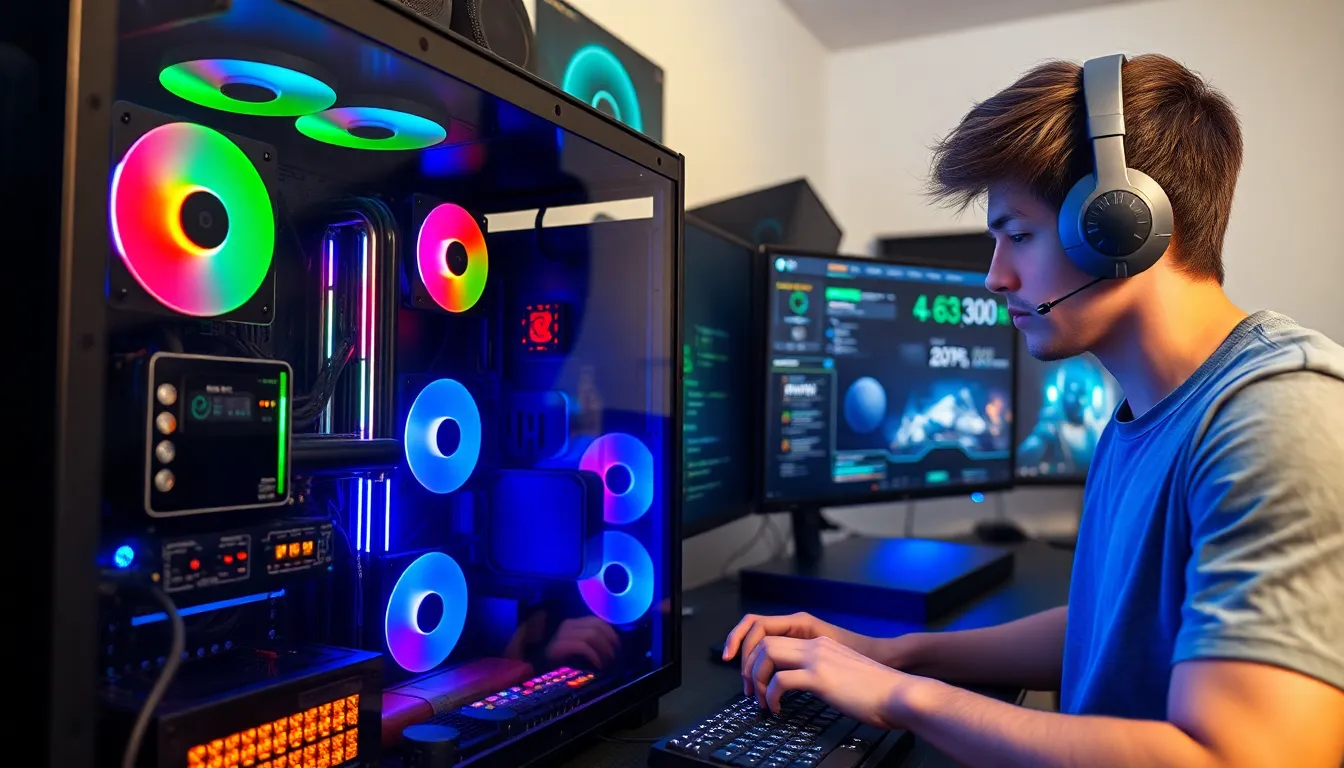Table of Contents
ToggleIn the world of gaming and high-performance computing, overclocking a CPU is like adding a turbocharger to a sports car. It’s all about squeezing out those extra frames per second or getting that rendering time down to mere moments. But before diving headfirst into this exhilarating realm, one must understand the risks and rewards that come with pushing a processor beyond its factory limits.
Understanding Overclocking
Overclocking involves running a CPU at a higher speed than its factory settings. This practice enhances performance in various computing tasks.
What Is Overclocking?
Overclocking refers to adjusting the CPU’s clock rate beyond the manufacturer’s specifications. This process increases the number of cycles per second, allowing the CPU to execute tasks more quickly. It commonly involves changing settings in the BIOS or using software tools designed for this purpose. It’s crucial to monitor temperatures while overclocking, as excessive heat can lead to hardware damage. Users often seek to improve system responsiveness and application performance through this method.
Why Overclock a CPU?
Overclocking a CPU offers significant performance boosts for gaming and intensive applications. Increased frames per second leads to smoother gameplay and improved user experience. Additionally, reduced rendering times enhance efficiency in creative tasks, such as video editing or 3D modeling. Enthusiasts often enjoy the challenge of pushing their hardware to new limits. They might aim for competitive advantages in gaming or maximum productivity in professional tasks. While the risks include potential overheating and stability issues, the rewards can outweigh these concerns for many users.
Benefits of Overclocking

Overclocking a CPU provides several advantages that can significantly enhance computing performance. Many users experience improved performance across various applications and tasks.
Improved Performance
Enhanced performance results from increased clock speeds that allow processors to execute operations more quickly. Applications like video editing, 3D rendering, and compiling code benefit from these gains as tasks finish sooner. Users often notice smoother multitasking capabilities when several programs run simultaneously. Additionally, higher frame rates occur during gaming, resulting in a more fluid experience. Optimized resource management maximizes the efficiency of the CPU, making it crucial for power users seeking every bit of performance.
Enhanced Gaming Experience
Gaming experiences reach new heights through overclocking. Gamers frequently enjoy higher frames per second, which translates into seamless gameplay. Increased clock speeds also reduce lag during intense gaming sessions, improving reaction times. With a more powerful CPU, graphic settings can increase without sacrificing performance. As a result, games appear more visually appealing and immersive. Competitive players achieve an edge, as faster processing speeds allow for quicker responses to in-game events. Enhanced gaming performance attracts many enthusiasts, motivating them to explore advanced overclocking techniques for optimal results.
Risks of Overclocking
Overclocking a CPU provides substantial performance benefits but carries inherent risks. Understanding these risks is crucial for making informed decisions.
Heat Generation
Increased clock speeds lead to higher heat output. Under overclocking conditions, temperatures can quickly exceed safe levels. Prolonged exposure to excessive heat diminishes CPU lifespan. Monitoring temperatures with software tools proves essential for preventing thermal issues. Airflow in the case must accommodate the elevated heat levels. Enhanced cooling solutions, such as liquid cooling systems or upgraded air coolers, can mitigate heat risks. Failure to manage heat can result in throttling or system crashes, negatively impacting performance. Users must assess cooling needs before attempting significant overclocks.
Potential Hardware Damage
Overclocking poses a risk of hardware damage, particularly if voltage levels are improperly set. Excess voltage can lead to unstable operations and physical damage to the CPU. Components like the motherboard, memory, and power supply can also suffer from stress. Reliability decreases with increased wear on parts due to high temperatures and voltage. Implementing preventive measures, such as gradual increases in clock speed, helps in assessing system stability. Regular stress testing after adjustments ensures components can handle overclocked settings without failure. Long-term consequences can include degraded performance and reduced functionality.
How to Overclock Your CPU
Overclocking a CPU requires careful planning and the right tools. Key tools and software simplify the process and ensure safety.
Necessary Tools and Software
A reliable motherboard allows for customizable BIOS settings. Users typically benefit from monitoring software like HWMonitor or Core Temp, which provide real-time temperature readings. Stress testing applications such as Prime95 or AIDA64 help evaluate system stability after changes. These tools assist in observing performance enhancements and identifying potential issues. Additionally, thermal paste improves heat transfer between the CPU and cooler. An efficient cooling solution, such as air or liquid cooling, mitigates heat generation. Finding the right combination of these tools is crucial for successful overclocking.
Step-by-Step Guide
Begin by entering the BIOS setup during system boot. Adjust the CPU multiplier and clock speed incrementally to prevent instability. Save changes and exit BIOS, then assess system stability using stress testing software. Monitor temperatures closely; aim to keep CPU temperatures below 85°C under load. If instability or overheating occurs, revert adjustments or refine settings. Gradually increase voltage only if necessary, while remaining cautious of maximum limits. Repeat this process until the desired performance level is achieved while ensuring system reliability. Regular monitoring after overclocking maintains optimal performance and longevity.
Overclocking a CPU offers a compelling way to enhance performance for gaming and intensive applications. By pushing the processor beyond its factory settings users can experience smoother gameplay and faster rendering times. However it’s crucial to approach this process with caution. Understanding the balance between increased performance and potential risks like overheating is essential.
With the right tools and monitoring techniques users can reap the benefits of overclocking while maintaining system stability. The journey into overclocking can be rewarding for those seeking to maximize their computing power. Ultimately careful planning and execution can lead to a more enjoyable and efficient computing experience.




